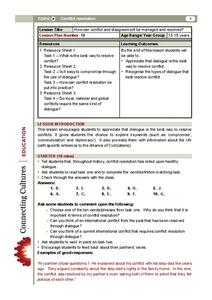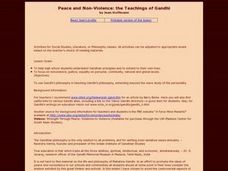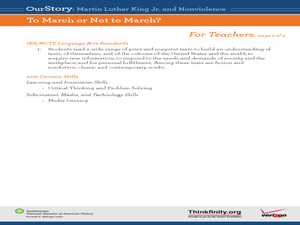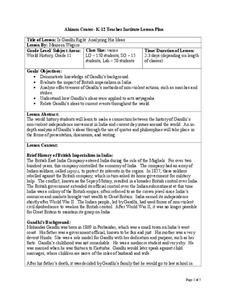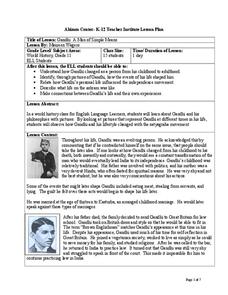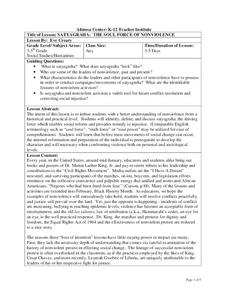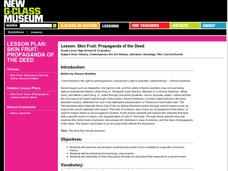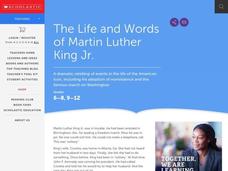Newseum
Making a Change: Letter From Birmingham Jail
Martin Luther King Jr.'s "Letter From Birmingham Jail" was written in response to "A Call for Unity," written by eight white ministers from Birmingham and published in the local newspaper. After reading both letters and following a list...
Macmillan Education
Communicate/Cooperate
Prepare pupils to communicate effectively throughout their lives with this set of worksheets and activities, which are part of a 23-instructional activity series on valuable life skills. Class members will define communication and...
University of the Desert
How Can Conflict and Disagreement be Managed and Resolved?
As you explore the meaning of cultural understanding and diffusion with your learners, discuss how dialogue can play a role in resolving conflicts based on misunderstanding. Examine keywords such as compromise, communication, and...
Curated OER
Peace and Non-Violence: the Teachings of Gandhi
Students study the Gandhian philosophy. They define certain elements such as power, beauty and discuss what they know about the struggle for independence in India. Finally students collaborate to discuss Gandhian principles to extend...
Curated OER
To March or Not to March?
Students read historical artifacts about the March on Washington for Jobs and Freedom and analyze the choices made during the time. In this March on Washington lesson, students read Martin's Big Words and the 'Step Back in Time' sheets....
Curated OER
Culture Creation vs. Culture Consumption - Finding Voice Through Digital Storytelling
Ninth graders explore the power of media in culture and Gandhi's philosophy of nonviolence. In this nonviolence and media lesson, 9th graders analyze Gandhi's nonviolent methods for social change and discuss the media's power to create...
Curated OER
Journey to Synergy on the path of Gandhi and King
Young scholars explore the concept of synergy. In this peace and tolerance instructional activity, students read sections of The 7 Habits of Highly Effective Teens by Covey and then discuss how Gandhi and King mastered the art of...
Curated OER
The Civil Rights Movement
Students explore the events of the Civil Rights Movement. In this research skills lesson, students research the important figures, events, and ideas of the American Civil Rights Movement as they visit suggested websites that feature...
Curated OER
Gandhi's Salt March, A Simulation
Young scholars examine Gandhi's Salt March. In this peace and tolerance lesson, students discuss the Salt Tax Levy that was imposed in India. Young scholars then debate how the Indian National Congress should have handled the issue.
Curated OER
Is Gandhi Right: Analyzing His Ideas
Students explore the connection between Gandhi and the Independence Movement in India. In this lesson on social change, students examine the ideas of Gandhi to analyze non violent change. Students consider the impact of British...
Curated OER
Gandhi: A Man of Simple Means
Eleventh graders examine the life of Mohandas Gandhi. In this Gandhi lesson, 11th graders listen to their instructor present a lecture regarding the details of the Gandhi's life and respond to the provided discussion questions.
Curated OER
Satyagraha: The Soul Force of Nonvilence
Students discuss what satyagraha is understanding that it is the driving force which enables social reform. In this social science lesson, students try to internalize the principles of nonviolence on an individual level and then a global...
Curated OER
Ordinary People, Ordinary Places: The Civil Rights Movement
Students analyze Martin Luther King's message of nonviolent protest discover how individuals adapted his message to their own communities and situations.
Curated OER
Court Documents Related to Martin Luther King, Jr., and Memphis Sanitation Workers
Learners read about the civil rights movement in their textbooks. They engage in a whole-class discussion of how nonviolent direct action can be a powerful tool for bringing about social, economic, or political change.
Curated OER
The March from Selma to Montgomery
Students examine voter discrimination. In this Civil Rights lesson, students watch segments of "Eyes on the Prize" and discuss the organization of the march from Selma to Montgomery. Students conduct interviews to learn...
Curated OER
Looking for Heroes
Students explain the importance of the 1965 Selma-to-Montgomery Voting Rights March and the long term impact in the US of non violent civic participation.
Curated OER
Voting Then and Now
Students consider the impact of the Voting Rights Act as they examine voting practices today. In this voting lesson, students research details regarding the Voting Rights Act and then read a handout regarding voting data from the early...
Curated OER
Selfless Service and The Giving Tree - Building Ethical Conscience
Upper elementary schoolers investigate philanthropy and selflessness by reading a children's book. In this ethics lesson, they read The Giving Tree by Shel Silverstein, and research Mahatma Gandhi's troublesome, yet inspiring, life....
Tolerance
A Time for Justice
The Academy Award-winning documentary A Time for Justice launches a unit that examines America's civil rights movement. Class members examine key events and participants in the movement and consider how the civil rights movement...
Curated OER
Lesson: Skin Fruit: Propaganda of the Deed
Art can express acts of injustice and move society to action. Upper graders analyze contemporary art relating to specific moments in history. They discuss propaganda, anarchy, sociology, and violence as activism. After researching and...
Curated OER
Civil Disobedience from Antigone to Hunger Games
Study the concepts and practice of civil disobedience through fiction and nonfiction texts.
Curated OER
5 Broken Cameras: How Storytellers Shape the Story
5 Broken Cameras, the award-winning documentary nominated for a 2013 Academy Award and winner of the Sundance 2012 Directors Award is the focus of a resource packet that includes a lesson plan, discussion guide, reading lists, background...
Wisconsin Historical Society
Civil Disobedience
When is civil disobedience acceptable? Class members read examples of Jim Crow laws, an excerpt from Dr. Martin Luther King's "Letter from a Birmingham Jail," and a newspaper article and then consider the factors that make a law just or...
Scholastic
The Life and Words of Martin Luther King, Jr.
Here is a precise article explaining chronological events that led Martin Luther King, Jr. to march for freedom and civil rights.
Other popular searches
- Nonviolence Gandhi
- Nonviolence Speech
- Nonviolence Protests
- Nonviolence India
- Nonviolence Bullying
- Nonviolence Fifth Grade
- Nonviolence Gandi
- Nonviolence 4th Grade
- Nonviolence Candi
- Nonviolence + Gandhi
- Nonviolence Northern Ireland




